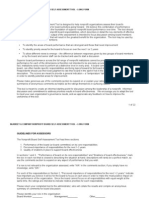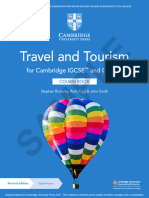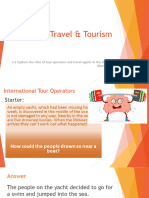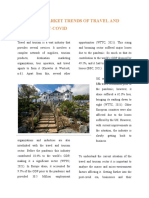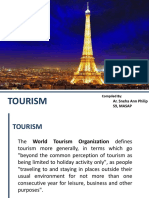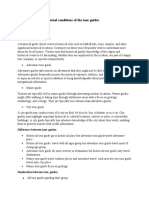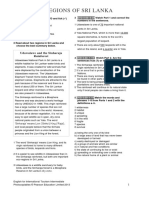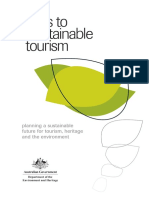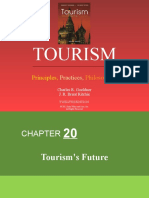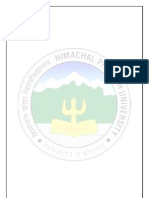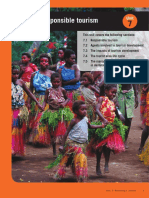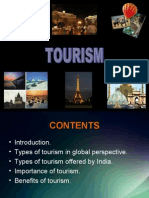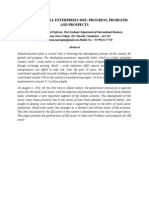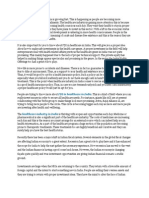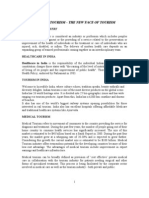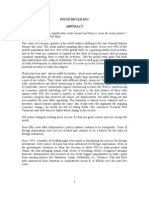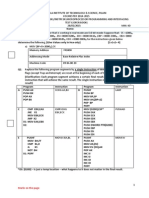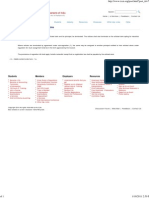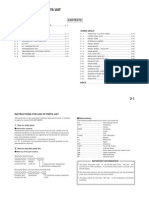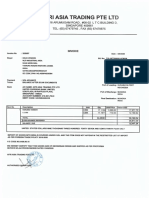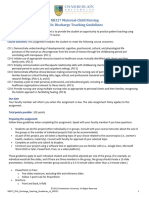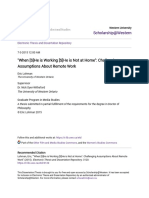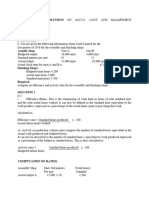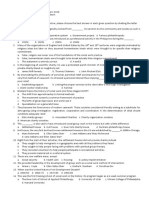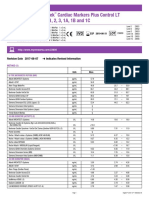Medical Tourism - GRA
Medical Tourism - GRA
Uploaded by
UlsasiCopyright:
Available Formats
Medical Tourism - GRA
Medical Tourism - GRA
Uploaded by
UlsasiCopyright
Available Formats
Share this document
Did you find this document useful?
Is this content inappropriate?
Copyright:
Available Formats
Medical Tourism - GRA
Medical Tourism - GRA
Uploaded by
UlsasiCopyright:
Available Formats
MEDICAL TOURISM THE NEW FACE OF TOURISM
HEALTHCARE INDUSTRY The health care industry is considered an industry or profession which includes peoples exercise of skill or judgment or the providing of a service related to the preservation or improvement of the health of individuals or the treatment or care of individuals who are injured, sick, disabled, or infirm. The delivery of modern health care depends on an expanding group of trained professionals coming together as an interdisciplinary team. MEDICAL TOURISM Medical Tourism refers to movement of consumers to the country providing the service for diagnosis and treatment. During the past few years, the number of people going out of their home country to consume health services has significantly increased. The size of this market is estimated to be $40 billion based on a Saudi Report in 2000. During the past four years, the market grew at a whopping rate of 20-30% and is expected to grow further. Considering this growth the current market size is estimated to be $100 billion. Medical Tourism industry offers tremendous potential for the developing countries because of their low-cost advantage. The advantages of medical tourism include improvement in export earnings and healthcare infrastructure. WHY INDIA? The countries where medical tourism is being actively promoted include Greece,
South Africa, Jordan, India, Malaysia, Philippines and Singapore. India is a recent entrant into medical tourism. According to a study by McKinsey and the Confederation of Indian Industry, medical tourism in India could become a $1 billion business by 2012. The report predicts that: "By 2012, if medical tourism were to reach 25 per cent of revenues of private up-market players, up to 2,297,794,117 USD will be added to the revenues of these players". The Indian government predicts that India's $17-billion-a-year health-care industry could grow 13 per cent in each of the next six years, boosted by medical tourism, which industry watchers say is growing at 30 per cent annually. Price advantage is a major selling point. The slogan, thus is, "First World treatment' at Third World prices". The cost differential across the board is huge: only a tenth and sometimes even a sixteenth of the cost in the West. Table No.1 The Comparative rates of surgeries Surgeries Open Heart Surgery (CABG) Total Knee Replacement Hip Resurfacing LA Hysterectomy Lap Cholcystectomy Spinal Decompression Fusion India ($) 7,500 6,300 7,000 4,000 3,000 5,500 USA ($) 100,00 0 48,000 55,000 22,000 18,000 60,000 UK (GBP) 21,400 25,700 24,100 11,800 9,600 32,100
Obesity Surgery (Gastric Bypass)
9,500
65,000
34,800
Dental, eye and cosmetic surgeries in Western countries cost three to four times as much as in India. India has a lot of hospitals offering world class treatments in nearly every medical sector. MEDICAL INDUSTRY TOURISM AS AN
Medical tourism can be broadly defined as provision of cost effective private medical care in collaboration with the tourism industry for patients needing surgical and other forms of specialized treatment. This process is being facilitated by the corporate sector involved in medical care as well as the tourism industry - both private and public. BENEFITS TOURISM Tangible Foreign exchange earrings which enable economic wealth of nation Cost Advantage in Tariff over the Developed countries Improve information sharing Increase in efficiency of patient care process, cutting edge treatment. Improvement in hospital supply chain efficiency Strategic alliances with business partners within and outside the country Technology and Knowledge Transfer Better logistics performance both in internal and external OF MEDICAL
Creation of employment opportunities in the industry Better utilization of Infrastructure and skilled manpower Opportunity for development in Infrastructure in Health, Tourism and Travel. Economies of scale. Connectivity with air, road, rail and information and communication industries Clustering of medical Travelers Health opportunities for foreign patients may lead to better standards at home. Scope for Research and Development to offer comprehensive medical solutions. Intangible International acceptance of country as a global healthcare provider Social and cross cultural experience International customer relations Global Marketing and Medical Trade relations Brand image of nation as worldclass healthcare destination. Competitive advantage Better coordination among the partners i.e. hospital and hospitality industry. Public and Private Partnerships Patient satisfaction MEDICAL TOURISM IN INDIA THE CURRENT SCENARIO Medical Tourism is poised to be the next Indian success story after Information Technology. According to a MckinseyCII study the industrys earning potential estimated at Rs.5000-10000 Crores by 2012. Worldwide, healthcare is said to be a $3-trillion industry, and India is in a
position to tap the top-end segment by highlighting its facilities and services, and exploiting the brand equity of leading Indian healthcare professionals across the globe. Medical Tourism", the term refers to the increasing tendency among people from the UK, the USA and many other third world countries, where medical services are either very expensive or not available, to leave their countries in search for more affordable health options, often packaged with tourist attractions. More importantly, Medical Tourism is growing rapidly and turning out to be an immense business opportunity for nations that are positioning themselves correctly. Last year, just five countries in Asia Thailand, Malaysia, Jordan, Singapore and India- pulled in over 1.3 million medical travelers and earned over $1billion (in treatment costs alone). In each of these nations, medical travel spends are growing at 20% plus year-onyear. Elsewhere around the world, Hong Kong, Lithuania and South Africa are emerging as big medical/healthcare destinations. HEALTH TOURISM IN INDIA ADVANTAGES AND OPPORTUNITIES The inflow of health tourists from the West, especially the UK, US and some of the European countries has been on the rise for the last couple of years. Price difference or affordability of the treatment, coupled with quality of doctors are the main reasons for the growing western traffic.
The quality of Indian hospitals has improved significantly and now matches with the best in any part of the world. India has more than 100 healthcare institutions, which are of international standard. Many hospitals in India today have the infrastructure and equipment that match with the best centers in the world, be it transplantations(liver/kidney/heart or bone marrow), cancer treatment, including radiotherapy, neurosurgery, including sterotactic surgery., angioplasty and cardiac surgery (bypass and paediatric) Public-Private Partnership combines internal hospital expertise with supply chain and logistics expertise. The SWOT analysis of Indian medical tourism business is: Table No.2 Weaknesses 1) Lack of infrastructure 1) Quality of service 2) Lack of uniform 2) Exquisite Locationspricing policy 3) Alternative medical 3) Poor infrastructure in cures like Yoga, Govt. Aided hospitals Homeopathy and 4) Lack of proper Ayurveda. Institute on medical Instrumentation. Opportunities Threats 1) Impact on Forex reserve 1) Foreign players may 2) Contributions in enter into the market GDP 2) Lack of foreign 3) Sharp rise in accreditation medical as well as tourism Industry. Strength
ROLE OF GOVERNMENT The role of Indian Government for success in medical tourism is two-fold: Acting as a Regulator to institute a uniform grading and accreditation system for hospitals to build consumers trust. Acting as a Facilitator for encouraging private investment in medical infrastructure and policy-making for improving medical tourism. For facilitating investment the policy recommendations include: Recognize healthcare as an infrastructure sector, and extend the benefits under sec 80-IA of the IT Act. Benefits include tax holidays for five years and concessional taxation for subsequent five years. The government should actively promote FDI in healthcare sector. Conducive fiscal policies providing low interest rate loans, reducing import/excise duty for medical equipment Facilitating clearances and certification like medical registration number, antipollution certificate etc. The above measures will kick-start hospital financing, which is struggling now due to capital intensive and low efficiency nature of healthcare business. For facilitating tourism the government should:
Reduce hassles in visa process and institute visa-on-arrival for patients Follow an Open-Sky policy to increase inflow of flights into India Create Medical Attachs to Indian embassies that promote health services to prospective Indian visitors
GOVERNMENT PLANS FOR ATTRACTING MEDICAL TOURISM TO INDIA To promote growth in the Indian medical travel industry, the Indian government has plans to improve health infrastructure. The government is currently in the process of increasing the number of hospitals, clinics, and clinical laboratories in urban as well as rural parts of the country. Incentives and tax holidays are being offered to hospitals and dispensaries providing health travel facilities. The Indian medical travel and health care sector offers plenty of opportunities for businessmen, medical equipment manufacturers, healthcare service providers, and tourist agencies, and the government is encouraging them to invest in therapeutic and preventive health services so as to increase medical travel to India. The government has published analytical reports on the available opportunities in the Indian health care industry so corporate houses can make informed decisions regarding the Indian medical tourism sector. PRICE The price range offered by the Indian medical industry is unbelievable because
India offers the most reasonable prices. India is not only cheaper but the waiting time is almost nil. This is due to the outburst of the private sector which comprises of hospitals and clinics with the latest technology and best practitioners. Table No.3 PROCEDURE US India CHARGES IN (USD) (USD) INDIA & USA Approx Approx Bone Marrow USD USD Transplant 2,50,000 69,200 Liver USD USD Transplant 3,00,000 69,350 Heart Surgery USD USD 30,000 8,700 Orthopedic USD USD Surgery 20,000 6,300 Cataract USD USD Surgery 2,000 1,350 Smile USD USD Designing 8,000 1,100 Metal Free USD USD Bridge 5,500 600 Dental Implants USD USD 3,500 900 Porcelain Metal USD USD Bridge 3,000 600 Porcelain Metal USD USD Crown 1,000 100 Tooth USD USD Impactions 2,000 125 Root Canal USD USD Treatment 1,000 110 Tooth USD USD Whitening 800 125 Tooth Colored USD USD 30 Composite 500 Fillings / Tooth USD USD 90
Cleaning
300
PROCEDURE CHARGES IN INDIA & UK Significant cost differences exist between UK and India when it comes to medical treatment. Accompanied with the cost are waiting times which exist in UK for patients which range from 3 months to over months. Table No.4 UK India (USD) (USD) Procedure Approx Approx Open Heart USD USD Surgery 18,000 4,800 Cranio-Facial USD USD surgery and 13,000 4,500 skull base NeuroUSD USD surgery with 21,000 6,800 Hypothermia Complex USD USD spine surgery 13,000 4,600 with implants Simple Spine USD USD Surgery 6,500 2,300 Simple Brain Tumor USD USD1,200 - Biopsy 4,300 USD - Surgery USD 4,600 10,000 Parkinsons - Lesion - DBS USD 6,500 USD 26,000 Hip USD Replacement 13,000 USD 2,300 USD 17,800 USD 4,500
PROMOTIONAL ACTIVITIES TO PROMOTE MEDICAL TOURISM CME ( Continuous medical education for doctors) Patient Education Progress Free health Checkup camps. Tie ups with various hospitals and insurance companies abroad. Participation in Health Expos abroad. Tie ups with Embassies. Advertisement campaigns. Nodal centers in other countries. Reduction of Excise duty from 17% to 8% on all goods produced in the pharmaceutical sector as per the Budget 20082009.
Source: Business World India and Indian Brand Equity Foundation As the table above shows, India has significant cost advantages in several health procedures making it a preferred destination b)The Service Spectrum India offers a variety of services for overseas patients. The table below presents a classification of the service spectrum. Fig.2
FACTORS ENHANCING MEDICAL TOURISM IN INDIA a) Cost Competitiveness The Key driver The main reason for Indias emergence as a preferred destination is the inherent advantage of its healthcare industry. Today Indian healthcare is perceived to be on par with global standards. Some of the top Indian hospitals and doctors have strong international reputation. But the most important factor that drives medical tourism to India is its low cost advantage. Majority of foreign patients visit India primarily to avail of First World Service at Third World Cost. Fig.1
KEY CHALLENGES BEFORE INDIAN MEDICAL TOURISM: 1) Lack of Government support to promote medical tourism 2) Lack Of medical Infrastructure 3) Lack of international accreditation 4) Perception among the foreign tourist as an unhygienic country 5) Strong competition from Malaysia, Thailand and Singapore CONCLUSION c) Consumer Profile The demand for Indian healthcare services primarily comes from three types of consumers. The table below presents the profile of these three consumer groups: Fig.3 However, Medical tourism is the next best thing for India. According to the CII Mackinsey report, Medical Tourism in India is expected to bring revenue of over $2 billion by 2012.The object is to capitalise the low cost advantage and to attract medical tourist by providing attractive packages. Medical Tourism in India is booming and can be witnessed by the huge number of International tourist visiting this region. India is one of the worlds most preferred region of the world in the case of medical tourism due to the low cost of treatment, no waiting time, approachability, tourists spots in India and other value added services. As the Indian economy of growing so worlds best hospitals are coming to India to encash the opportunity. The healthcare industry has successfully managed to maintain the interest and attention of not only the Indian government, but also the common man. The top Indian hospitals such as Apollo, Escorts, Max, etc, are investing immense time, effort, manpower and money in their R&D. As a matter of fact, several new innovative products have been launched in the Indian market and have been patented. 7
Though tourism is not the primary need of these consumers, it offers additional attraction particularly for people traveling for cosmetic surgery and less complicated procedures.
The Indian consumer has ready access to new innovations in the field of health and medicine. The companies are constantly acquiring latest technology either through partnerships or developing them indigenously. The government is fully supporting the cause of state of the art infrastructure by providing support in setting up new hospitals and financing them. BIBLIOGRAPHY Alvarez, David P.; Connecting people to the promise of healtchare, No. 15 (2000) CII and Mekinsey, Healthcare In India The Road Ahead, (2006) Daschle Tom, Achieving Universal Health Coverage, (2007) Davenport Karen, Health Care Benefits, (2007) Hautea, Dr. Randy A.; Krattiger, Dr. Anatole F. And Van Zanten, Ir. Jasper E; Healthcare costs comparisons, No. 18 (2000) http://en.wikipedia.org/wiki/Healthcare_ in_India http://timesofindia.indiatimes.com/More _options_for_health_insurance/articlesh ow/1982238.cms http://www.cbc.ca/news/background/hea lthcare/medicaltourism.html http://www.deloitte.com/dtt/whitepaper/ 0,1017,sid%253D34239%2526cid %253D71669,00.html http://www.indiatogether.org/2007/jan/hl t-hltcare.htm http://www.nature.com/nm/journal/v9/n4 /full/nm0403-377a.html http://www.who.int/mediacentre/factshe ets/fs172/en/index.html Seshamani Meena, Opportunity Costs and Opportunities Lost: Businesses Speak Out About Health Care, (2007)
Sonam Jagasia, A Report on Medical Tourism in India Issue 2 (2008)
You might also like
- McKinsey & Co - Nonprofit Board Self-Assessment Tool Long FormDocument22 pagesMcKinsey & Co - Nonprofit Board Self-Assessment Tool Long Formmoctapka088100% (1)
- IGCSE Travel - Tourism CB - CI Sample - FINALDocument13 pagesIGCSE Travel - Tourism CB - CI Sample - FINALemaan.fpNo ratings yet
- MKT 3, Marketing in Travel and TourismDocument22 pagesMKT 3, Marketing in Travel and TourismDP100% (4)
- Cambridge IGCSE: Travel & Tourism 0471/11Document4 pagesCambridge IGCSE: Travel & Tourism 0471/11SikkenderNo ratings yet
- Understanding The CultureDocument16 pagesUnderstanding The CultureJames MacaspacNo ratings yet
- Tourism IGCSE Module 2Document13 pagesTourism IGCSE Module 2kevinnhabete585No ratings yet
- OECD Tourism TrendsDocument380 pagesOECD Tourism TrendssudamailNo ratings yet
- Tourism IGCSE Arts Module 1-2024Document4 pagesTourism IGCSE Arts Module 1-2024kevinnhabete585No ratings yet
- Unit 1-Study Material 1. Definition of Tourism: Tourism Concepts & Travel Agency Management/ Diat-01Document9 pagesUnit 1-Study Material 1. Definition of Tourism: Tourism Concepts & Travel Agency Management/ Diat-01suyash100% (1)
- IGCSE Travel Tourism U4 4.2Document60 pagesIGCSE Travel Tourism U4 4.2jehan1231927100% (1)
- Global Trends in TourismDocument7 pagesGlobal Trends in Tourismsainidharmveer1_6180No ratings yet
- Trend Report - Travel and TourismDocument14 pagesTrend Report - Travel and TourismAhmed MemonNo ratings yet
- Unit 04 - Travel and Tourism Products and ServicesDocument39 pagesUnit 04 - Travel and Tourism Products and Servicesroshanehk100% (1)
- Tourism ManagementDocument7 pagesTourism Managementvenkatachalam venkatNo ratings yet
- 03 Tourism OrganizationDocument27 pages03 Tourism OrganizationMd. Abul Kashem NafiNo ratings yet
- Travel Agency Op MGT 260214 PDFDocument308 pagesTravel Agency Op MGT 260214 PDFnimeshshres100% (1)
- Customer Satisfaction at Bhagyashri Travels PVTDocument75 pagesCustomer Satisfaction at Bhagyashri Travels PVTsadsea2003No ratings yet
- Cyber TourismDocument10 pagesCyber TourismyatiejamilNo ratings yet
- Sustainability in TourismDocument10 pagesSustainability in TourismNoeen FatmaNo ratings yet
- Year End 2022 Tourism Measures1 0Document33 pagesYear End 2022 Tourism Measures1 0BernewsAdminNo ratings yet
- Tourism Class 1Document23 pagesTourism Class 1gowthami mNo ratings yet
- Tour Guide AssigmentDocument4 pagesTour Guide AssigmentDinithi NathashaNo ratings yet
- Chapter 3 (1) .pptx-1Document29 pagesChapter 3 (1) .pptx-1tally8285No ratings yet
- SUSTAINABLE Responsible TourismDocument19 pagesSUSTAINABLE Responsible TourismJhoanna NatividadNo ratings yet
- Climate Change and Tourism PDFDocument24 pagesClimate Change and Tourism PDFDavid D'bayuNo ratings yet
- 06 Organizations in The Distribution ProcessDocument28 pages06 Organizations in The Distribution ProcessMd. Abul Kashem NafiNo ratings yet
- History of Travel and TourismDocument6 pagesHistory of Travel and TourismInes Barrelas100% (1)
- UNWTO International Tourism HighlightsDocument24 pagesUNWTO International Tourism HighlightsJoji Rose Parondo AngNo ratings yet
- T02-Chapter 1 - Tourism in PerspectiveDocument9 pagesT02-Chapter 1 - Tourism in PerspectiveMinh HongNo ratings yet
- Destination-Analysis-Bay of Islands - New ZealandDocument12 pagesDestination-Analysis-Bay of Islands - New ZealandRiya DebnathNo ratings yet
- Int Tourism CH 11 Social and Cultural Aspects of TourismDocument16 pagesInt Tourism CH 11 Social and Cultural Aspects of Tourismchary83No ratings yet
- Efit Int DVD Eco-Regions of SL FinalDocument4 pagesEfit Int DVD Eco-Regions of SL Finalmaria catalina corrales rojasNo ratings yet
- 10 Steps To Sustainable TourismDocument76 pages10 Steps To Sustainable TourismLuis PeñaNo ratings yet
- Your Results For: "Multiple Choice"Document3 pagesYour Results For: "Multiple Choice"Ravi SatyapalNo ratings yet
- Strategic Use of Information Technologies in The Tourism IndustryDocument25 pagesStrategic Use of Information Technologies in The Tourism IndustryJelena エレナ МiljanicNo ratings yet
- Tourism and Hospitality Management PDFDocument228 pagesTourism and Hospitality Management PDFGreen CoolarmyNo ratings yet
- Project Report On Marketing Planning Strategy by SotcDocument52 pagesProject Report On Marketing Planning Strategy by SotcAnkush Bhatia83% (12)
- Domestic Tourism International Tourism: The Nature of TourDocument23 pagesDomestic Tourism International Tourism: The Nature of TourJeffrey TuballaNo ratings yet
- Specialization in TourismDocument12 pagesSpecialization in TourismItalo Arbulú Villanueva0% (1)
- History of Tourism Industry. The Development of Tourism in 19 and 21 CenturiesDocument20 pagesHistory of Tourism Industry. The Development of Tourism in 19 and 21 CenturiesKarina Rakhmatullaeva100% (1)
- Marketing in TourismDocument53 pagesMarketing in TourismayangkoyangNo ratings yet
- TRAVEL AGENCY PRELIM TOPICS-compressedDocument114 pagesTRAVEL AGENCY PRELIM TOPICS-compressedTravis AurelioNo ratings yet
- English For Tourism - Fall 2023Document9 pagesEnglish For Tourism - Fall 2023leenrq999No ratings yet
- Economic Impact of Tourism in EgyptDocument40 pagesEconomic Impact of Tourism in Egyptshinkoicagmailcom100% (2)
- 11 Tourism FutureDocument9 pages11 Tourism FutureMd. Abul Kashem NafiNo ratings yet
- Customer Loyalty and The Impacts of Service Quality: The Case of Five Star Hotels in JordanDocument7 pagesCustomer Loyalty and The Impacts of Service Quality: The Case of Five Star Hotels in JordanBella AndikaNo ratings yet
- Covid-19 Impact in Tourism SectorDocument7 pagesCovid-19 Impact in Tourism SectorAhmed Tausif RezaNo ratings yet
- Sustainable Tourism A Case of Destination Competitiveness in South AsiaDocument7 pagesSustainable Tourism A Case of Destination Competitiveness in South AsiaklarisaNo ratings yet
- Responsible Tourism and The MarketDocument6 pagesResponsible Tourism and The MarketOskar SavarinNo ratings yet
- Tourism Marketing As Promotion of Tourism in Himachal PradeshDocument24 pagesTourism Marketing As Promotion of Tourism in Himachal PradeshRakesh KumarNo ratings yet
- Opportunities and Challenges of Tourism Industry in The Context of Visit Nepal 2020Document14 pagesOpportunities and Challenges of Tourism Industry in The Context of Visit Nepal 2020rabin rajbanshiNo ratings yet
- Fundamentals of TourismDocument5 pagesFundamentals of TourismJuly GacetaNo ratings yet
- How Necessary Is A College EducationDocument5 pagesHow Necessary Is A College EducationHairi100% (1)
- Chapter 2 - Tourism Structure and ComponentDocument43 pagesChapter 2 - Tourism Structure and ComponentAmin EmengtoNo ratings yet
- Chapter 1 - Overview of TourismDocument29 pagesChapter 1 - Overview of TourismLongNo ratings yet
- Responsible Tourism: U 7: R U 7: RDocument38 pagesResponsible Tourism: U 7: R U 7: RRashidul SeamNo ratings yet
- Introduction. Types of Tourism inDocument12 pagesIntroduction. Types of Tourism inShantanu Dubey100% (3)
- Sustainable TourismDocument21 pagesSustainable TourismChristian TuberaNo ratings yet
- Global Sustainable Tourism Criteria For DestinationsDocument7 pagesGlobal Sustainable Tourism Criteria For DestinationsYeraldin SotoNo ratings yet
- The Future Past of Tourism: Historical Perspectives and Future EvolutionsFrom EverandThe Future Past of Tourism: Historical Perspectives and Future EvolutionsNo ratings yet
- Promoting Regional Tourism Cooperation under CAREC 2030: A Scoping StudyFrom EverandPromoting Regional Tourism Cooperation under CAREC 2030: A Scoping StudyNo ratings yet
- Article Ready For PublicationDocument21 pagesArticle Ready For PublicationUlsasiNo ratings yet
- An Analysis On Containerized Cargo Services at Coimbatore CityDocument15 pagesAn Analysis On Containerized Cargo Services at Coimbatore CityUlsasiNo ratings yet
- International Business - India's FutureDocument24 pagesInternational Business - India's FutureUlsasiNo ratings yet
- Export House, Trading House, Star Trading House and Super Star Trading HouseDocument15 pagesExport House, Trading House, Star Trading House and Super Star Trading HouseUlsasiNo ratings yet
- Micro and Small Enterprises Mse: Progress, Problems and ProspectsDocument1 pageMicro and Small Enterprises Mse: Progress, Problems and ProspectsUlsasiNo ratings yet
- Health Care IndustryDocument3 pagesHealth Care IndustryUlsasiNo ratings yet
- Fast Food Industry & It'S Growth in IndiaDocument9 pagesFast Food Industry & It'S Growth in IndiaUlsasiNo ratings yet
- Medical Tourism - IJMDocument22 pagesMedical Tourism - IJMUlsasiNo ratings yet
- FDI in Retailing - AbstractDocument3 pagesFDI in Retailing - AbstractUlsasiNo ratings yet
- International Law Related To Immigration and HRDocument10 pagesInternational Law Related To Immigration and HRUlsasiNo ratings yet
- Design and Uses of Prestressed Concrete Columns: by Raymond ItayaDocument8 pagesDesign and Uses of Prestressed Concrete Columns: by Raymond ItayaVegetable BunNo ratings yet
- LEVY AND COLLECTION OF GST - AbhiDocument14 pagesLEVY AND COLLECTION OF GST - AbhiAbhishek Abhi100% (1)
- Welfare Services of Islamic BanksDocument9 pagesWelfare Services of Islamic BanksMayra NiharNo ratings yet
- Musefulukit Pdms PML Manual MapekovuzeredizDocument3 pagesMusefulukit Pdms PML Manual MapekovuzeredizRajeshSahuNo ratings yet
- Thesis Ton2Document27 pagesThesis Ton2jayson fabrosNo ratings yet
- Korn Ferry Ukraine Current Business ActionsDocument41 pagesKorn Ferry Ukraine Current Business ActionsKata DienesNo ratings yet
- Test 1 SDocument2 pagesTest 1 SsaimanobhiramNo ratings yet
- Termination or Assignment of Articles: Departments Members Students Industry Resources Showcase Other Imp. Links FaqsDocument1 pageTermination or Assignment of Articles: Departments Members Students Industry Resources Showcase Other Imp. Links FaqsVaibhav NagoriNo ratings yet
- 2010 CBR1000RRDocument45 pages2010 CBR1000RRHBerryNo ratings yet
- Delhi Veneers CompleteDocument6 pagesDelhi Veneers CompleteMbok JamuNo ratings yet
- NR327 RUA Discharge Teaching Guidelines v2 NOV21Document6 pagesNR327 RUA Discharge Teaching Guidelines v2 NOV21Gudyne WafubwaNo ratings yet
- Experiential LearningDocument5 pagesExperiential Learningmg9362No ratings yet
- Weekly Current Affairs Pro May 2nd WeekDocument119 pagesWeekly Current Affairs Pro May 2nd WeekDeepak ShahNo ratings yet
- Questions On PH CurvesDocument2 pagesQuestions On PH CurvesMurat KAYANo ratings yet
- Math Resource BookDocument163 pagesMath Resource Booknae100% (2)
- NaviPlanner BVS Users Manual 8.3Document213 pagesNaviPlanner BVS Users Manual 8.3bloodyspark77No ratings yet
- Ashish Project New PDFDocument66 pagesAshish Project New PDFBhushan KotkarNo ratings yet
- ANUM MUSTAFA - Advertisement About Wild Animal Parks - Comprehension Grade 7Document2 pagesANUM MUSTAFA - Advertisement About Wild Animal Parks - Comprehension Grade 7MOHAMMED FURQAN BIN MUSTAFANo ratings yet
- Fluid Power FormulasDocument4 pagesFluid Power FormulasmahaveenNo ratings yet
- Bohol Transportation GuidelinesDocument9 pagesBohol Transportation GuidelinesAiza GarnicaNo ratings yet
- C Language Questions and Answers: Visit For More: WWW - Learnengineering.InDocument43 pagesC Language Questions and Answers: Visit For More: WWW - Learnengineering.In5042 Jagan SNo ratings yet
- Challenging Assumptions On Remote WorkDocument189 pagesChallenging Assumptions On Remote WorkHadi SumartonoNo ratings yet
- Dissolution of Partnership Firm Under Indian Partnership Act 1932Document11 pagesDissolution of Partnership Firm Under Indian Partnership Act 1932ABHIGYAN MISHRANo ratings yet
- Questions and Answers For MGT 3 000 Level 23Document15 pagesQuestions and Answers For MGT 3 000 Level 23Monsonedu IkechukwuNo ratings yet
- Social WorkDocument7 pagesSocial WorkJomer James Madrilejos100% (1)
- Happy Tour and Travel PART2-1Document11 pagesHappy Tour and Travel PART2-1Katelyn Sillano100% (2)
- Joven Electric Com Product Instant Mc350 ASPDocument3 pagesJoven Electric Com Product Instant Mc350 ASPkcyeo76No ratings yet
- Genesis 2020 PDFDocument154 pagesGenesis 2020 PDFDilon FernandoNo ratings yet
- 23650Document25 pages23650Ade FeriyatnaNo ratings yet
